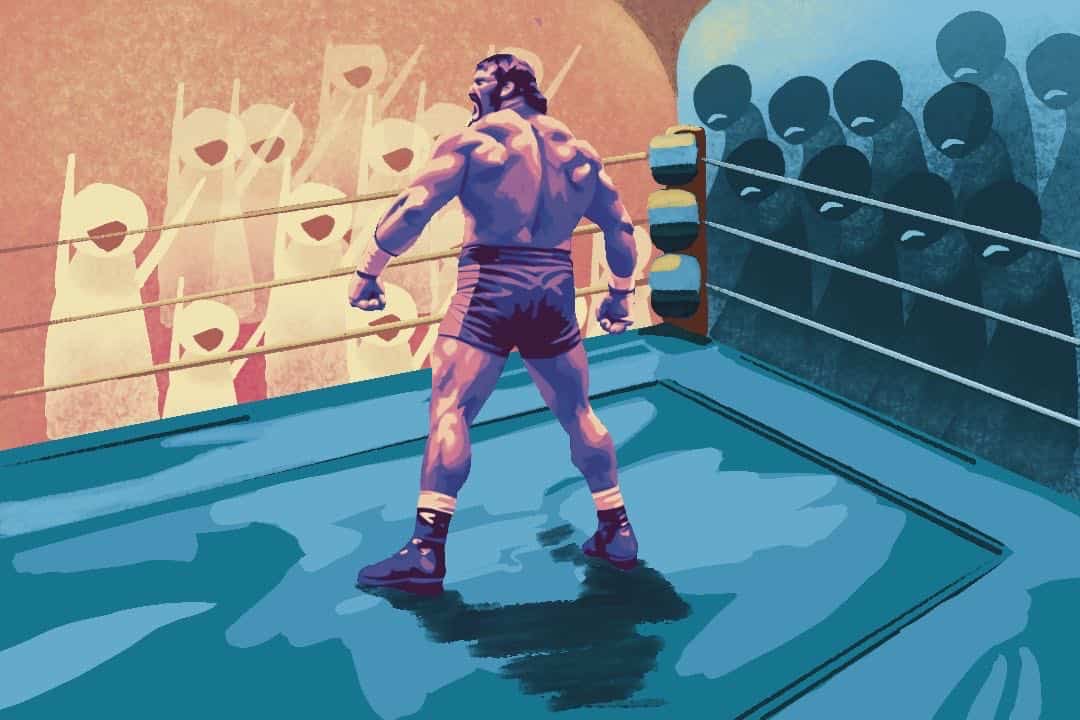Content warning: This article discusses substance use and exploitation in the wrestling industry, and mentions murder and suicide.
Words like “staged,” “fake,” and “dramatized” are often associated with professional wrestling. As a fan of the sport for over a decade, I have frequently struggled to explain to others what keeps me so invested. Perhaps it’s the larger-than-life portrayal of characters or the incredible display of skill and athleticism of the wrestlers. While these elements are significant, what truly captivates me is the behind-the-scenes reality — one often marked by tragedy shaped by years of substance use, injuries, and exploitation.
Professional wrestling is one of the most physically demanding professions one could pursue. Wrestlers are often performing up to 200 shows a year, travelling from one city to another while performing at the highest level. This relentless schedule takes a heavy toll on a wrestler’s physical and mental well-being. From the 1980s to the 2000s, many wrestlers turned to substance use to cope with the physical pain and mental stress of the job, often developing alcohol use disorders and resulting in painkiller usage. This was exacerbated by a lenient, nearly non-existent, drug testing policy in World Wrestling Entertainment (WWE).
Eddie Guerrero, one of the most beloved wrestlers of his era, was celebrated for both his tremendous in-ring skill and charismatic persona. Wrestling for nearly two decades across the globe, Guerrero faced significant challenges with substance use due to the profession’s demands. He developed an alcohol use disorder and painkiller usage, which severely impacted both his professional and personal life.
His story seemed to be one of redemption when he overcame his addictions and won a world title in 2004. Tragically, Guerrero passed away a year later at 38 from heart failure, shocking the wrestling world. His death reflected the dangerous culture in wrestling, where steroid and painkiller use was common, prompting the industry to adopt stricter drug-testing policies.
Chris Benoit, a Canadian professional wrestler and close friend of Guerrero, was widely regarded as one of the greatest wrestlers in the ‘90s due to his exceptional skill and intensity in the ring. Over his 22-year career, he wrestled worldwide and earned numerous accolades. However, in June 2007, Benoit shocked the world when he took the lives of his wife and son before taking his own.
This tragic incident brought intense media scrutiny to the wrestling industry. The most compelling explanation for Benoit’s actions was chronic traumatic encephalopathy, a brain condition caused by repeated head injuries. Doctors suggested that Benoit’s brain resembled that of an 85-year-old Alzheimer’s patient, likely due to multiple concussions. The wrestling industry’s health and wellness policies faced criticism for allowing performers to wrestle despite being in less-than-optimal physical condition, and raised serious concerns about its practices.
Phil Brooks, better known by his ring name CM Punk, rose to stardom in the mid-2000s. Renowned for his in-ring skills and hardcore personality, Punk was also vocal about the industry’s flaws. In January 2014, he abruptly left the WWE, sparking widespread speculation. Later that year, he revealed that his departure was due to the physical and mental toll of the WWE’s inadequate healthcare and a toxic work environment.
Punk’s revelations drew attention to significant issues within the wrestling industry, including the lack of union representation, exploitation of performers who are categorized as independent contractors rather than employees, and the culture of silence surrounding backstage abuses. Punk’s departure and subsequent comments sparked important discussions about wrestler welfare and the need for systemic changes within the industry. To this day, the WWE considers their athletes as contractors rather than employees, thus wrestlers are unable to unionise.
The combination of drug culture, physical strain, and an intense workload has led to a higher mortality rate among wrestlers compared to the general population. A 2014 University of Eastern Michigan study found that wrestlers aged 45–54 had a mortality rate 2.9 times greater than that of men in the broader US population, with cardiovascular disease being the most common cause of death. Well-known wrestlers such as Davey Boy Smith, Curt Hennig, Umaga, Bray Wyatt, and Rick Rude among others have passed away from heart failure. Additionally, performers like Crash Holly, Andrew “Test” Martin, Chyna, and Sherri Martel tragically lost their lives due to overdose.
Professional wrestling’s allure may lie in its spectacle and the athletic prowess of its performers, but the harsh realities behind the scenes cannot be ignored. The physical demands and lack of adequate support have led to untold suffering of many wrestlers. Both fans and the wrestling industry as a whole have a responsibility to advocate for better working conditions, healthcare, and overall support for the athletes who dedicate their lives to entertaining others.
While progress has been made, ongoing conversations and reforms are necessary to ensure the safety and well-being of all wrestlers, honouring their contributions while also safeguarding their futures.



No comments to display.